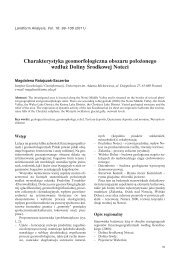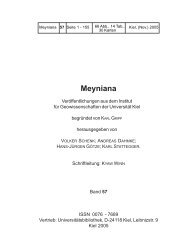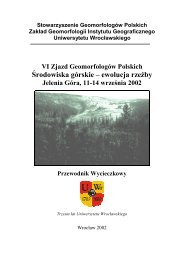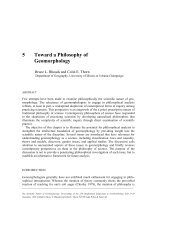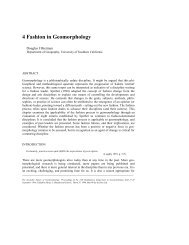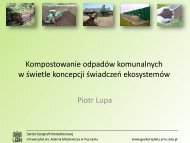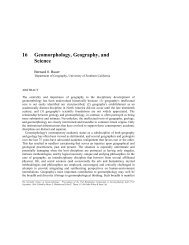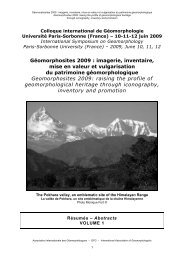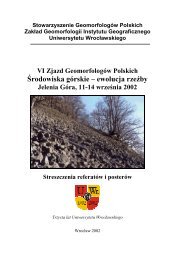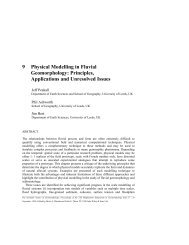Chapter 16 - Geomorphology, Geography, and Science Bernard 0
Chapter 16 - Geomorphology, Geography, and Science Bernard 0
Chapter 16 - Geomorphology, Geography, and Science Bernard 0
Create successful ePaper yourself
Turn your PDF publications into a flip-book with our unique Google optimized e-Paper software.
GEOMORPHOLOGY, GEOGRAPHY, AND SCIENCE 389<br />
into geomorphological thinking in geology. This 'new geography' favored inductive<br />
methods based on empirical observations over theoretical deduction, sought interpretations<br />
<strong>and</strong> explanations rather than mere descriptions, <strong>and</strong> was intensely interested in the<br />
interaction of humans with their natural environments. For a brief time (loosely, 1880 to<br />
1910) the geomorphological branches of geography <strong>and</strong> geology grew together - that is,<br />
the substance, method, <strong>and</strong> theory of geography, as they pertain to geomorphology, were<br />
those of geology as well.<br />
Harvard was the first North American university to offer specialized training in physical<br />
geography (physiography) within a geology department. The key geographer-geologists at<br />
Harvard were Nathaniel Southgate Shaler, who was a student of Louis Agassiz (Agassiz<br />
was educated in Switzerl<strong>and</strong>, taught at Harvard as a zoologist, <strong>and</strong> is noted by geomorphologists<br />
for his glacial theories), <strong>and</strong> William Morris Davis (an 'understudy' of Shaler<br />
<strong>and</strong> frequent visitor to Europe). This is not to say that North American geography relied<br />
solely on geology for intellectual stimulation. Indeed, it retained specializations <strong>and</strong> developed<br />
subdisciplinary interests outside of the geomorphological realm. At the Wharton<br />
School of Finance <strong>and</strong> Commerce (University of Pennsylvania), Emory R. Johnson, J.<br />
Paul Goode, <strong>and</strong> J. Russell Smith offered advanced education in economic <strong>and</strong><br />
transportation geography at the turn of the century. Yale University also had a geographic<br />
tradition that extended back to 1786 with the appointment of Jedidiah Morse. Geographic<br />
instruction at Yale during the latter part of the nineteenth century focused more on<br />
ontographical subject matter, <strong>and</strong> courses were offered by Daniel Coit Gilman, William H.<br />
Brewer, Francis A. Walker, <strong>and</strong> Herbert E. Gregory. Nevertheless, there was relatively<br />
little communication between these three groups, <strong>and</strong> as far as geomorphology (physiography)<br />
was concerned, the geological-geographical union at Harvard <strong>and</strong> elsewhere was<br />
natural <strong>and</strong> unquestioned.<br />
The activities <strong>and</strong> contributions of the key geomorphological figures at the turn of this<br />
century are good indicators of how intimate the linkage between academic geography <strong>and</strong><br />
academic geology was in the realm of geomorphological subject matter. It is widely<br />
acknowledged that John Wesley Powell (1834-1902), Grove Karl Gilbert (1843-1918),<br />
<strong>and</strong> William Morris Davis (1850-1934) played pivotal roles in the development of North<br />
American geomorphology. Powell <strong>and</strong> Gilbert, in particular, are often pointed to as epitomizations<br />
of the geological practitioner of geomorphology (e.g. Baker <strong>and</strong> Pyne 1978)<br />
whereas geographers, in retort, claim Davis as their geomorphological champion:<br />
For American geological geomorphologists, the most important scientific trinity was not<br />
structure, process, <strong>and</strong> stage, emerging from the heuristic synthesis of a Harvard scholar.<br />
Rather the critical trinity was Gilbert, Powell, <strong>and</strong> Dutton ... (Baker 1988, p. 1157).<br />
Such antithetical caricatures are, of course, a variation of the 'Championship of the<br />
Disciplines' <strong>and</strong> it is important to recognize they are not easily substantiated, nor even<br />
historically accurate (cf. Sack 1991, 1992).<br />
William Morris Davis was indeed very much a geographer. He was the primary<br />
influence behind organization of the Association of the American Geographers (AAG), he<br />
presided over the first meeting of the AAG in Philadelphia in December of 1904, was<br />
twice the elected President of the AAG (1905, 1909), he authored The Geographical<br />
Cycle (Davis 1899) <strong>and</strong> several other essays on geographical research <strong>and</strong> teaching, <strong>and</strong>



